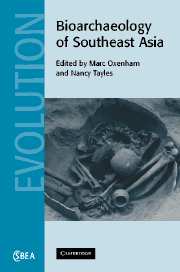Book contents
- Frontmatter
- Contents
- List of contributors
- Foreword: Emerging frontiers in the bioarchaeology of Southeast Asia
- Preface
- 1 Introduction: Southeast Asian bioarchaeology past and present
- Part I Morphological diversity, evolution and population relationships
- 2 The population history of Southeast Asia viewed from morphometric analyses of human skeletal and dental remains
- 3 A multivariate craniometric study of the prehistoric and modern inhabitants of Southeast Asia, East Asia and surrounding regions: a human kaleidoscope?
- 4 Interpretation of craniofacial variation and diversification of East and Southeast Asians
- 5 New perspectives on the peopling of Southeast and East Asia during the late upper Pleistocene
- 6 Human variation and evolution in Holocene Peninsular Malaysia
- 7 Dentition of the Batak people of Palawan Island, the Philippines: Southeast Asian Negrito origins
- Part II Health, disease and quality of life
- Part III Conclusions
- Index
- References
4 - Interpretation of craniofacial variation and diversification of East and Southeast Asians
Published online by Cambridge University Press: 18 November 2009
- Frontmatter
- Contents
- List of contributors
- Foreword: Emerging frontiers in the bioarchaeology of Southeast Asia
- Preface
- 1 Introduction: Southeast Asian bioarchaeology past and present
- Part I Morphological diversity, evolution and population relationships
- 2 The population history of Southeast Asia viewed from morphometric analyses of human skeletal and dental remains
- 3 A multivariate craniometric study of the prehistoric and modern inhabitants of Southeast Asia, East Asia and surrounding regions: a human kaleidoscope?
- 4 Interpretation of craniofacial variation and diversification of East and Southeast Asians
- 5 New perspectives on the peopling of Southeast and East Asia during the late upper Pleistocene
- 6 Human variation and evolution in Holocene Peninsular Malaysia
- 7 Dentition of the Batak people of Palawan Island, the Philippines: Southeast Asian Negrito origins
- Part II Health, disease and quality of life
- Part III Conclusions
- Index
- References
Summary
Introduction
The origins and affinities of Southeast Asians have been much debated over the years. The classic view held that the indigenous inhabitants of Southeast Asia were of Australian and Melanesian lineages. Then a wave of migrants from somewhere in southern China displaced and absorbed the majority of the indigenous population at some point between 4,000 and 5,000 years BP (Brothwell 1960, Howells 1976, 1977, Birdsell 1977, Bowles 1977, Glinka 1981, Bellwood 1985, 1987). In stark contrast to the population replacement model described above, other researchers espouse a local evolution model in which there was no significant gene flow into Southeast Asia from populations of East Asia (Bulbeck 1981, 1982, Omoto 1984, Turner 1987, 1990, 1992, Pietrusewsky 1988, Pietrusewsky and Chang 2003). Recently, Lahr (1996) and Underhill et al. (2001) have suggested that the colonisation of Southeast Asia by modern humans may have taken place through multiple dispersals. The first may have been an eastward movement of coastal peoples from East Africa to Arabia via the Horn, along the Indian Ocean rim towards Southeast Asia and finally into Australia. The second phase of modern occupation of Southeast Asia might have resulted from an expansion of the range of modern humans in North Africa and West Asia (Lahr 1996).
Turner (1987, 1990, 1992), Ballinger et al. (1992) and Chu et al. (1998) proposed that the human occupation of East and Northeast Asia resulted from the expansion of late Pleistocene Southeast Asians.
- Type
- Chapter
- Information
- Bioarchaeology of Southeast Asia , pp. 91 - 111Publisher: Cambridge University PressPrint publication year: 2006
References
- 12
- Cited by

